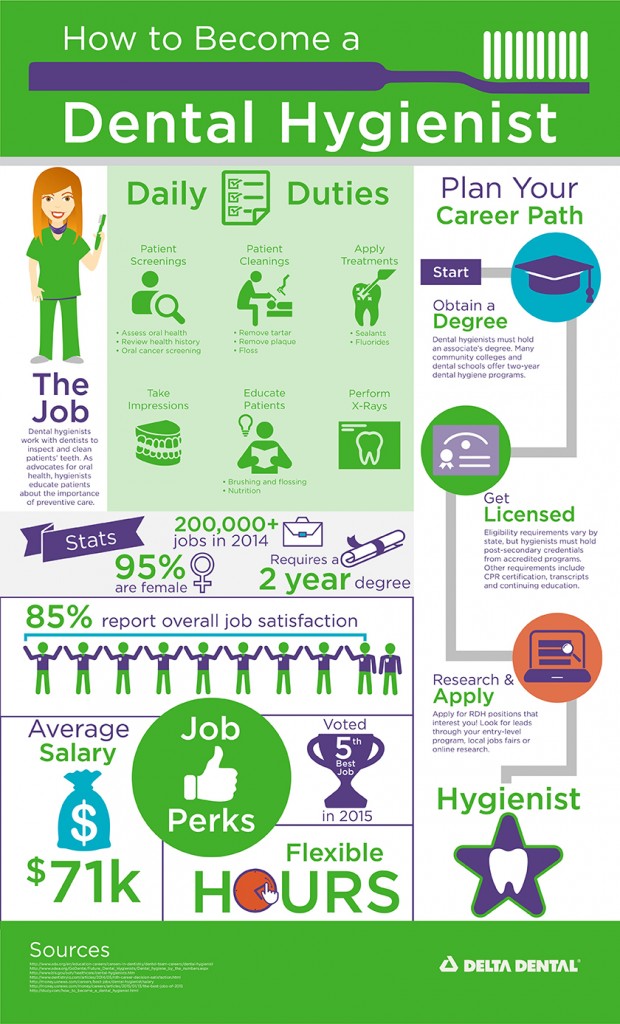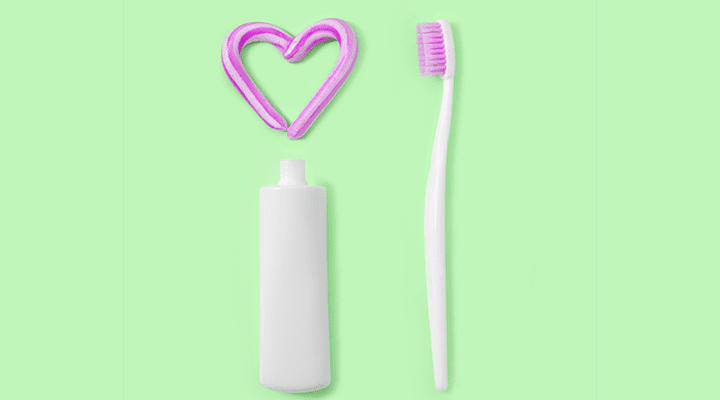Considering a career as a dental hygienist? As one of the fastest-growing jobs in America, there are many perks to stepping into the dental-sphere. Start your job journey with our hygienist infographic.

Considering a career as a dental hygienist? As one of the fastest-growing jobs in America, there are many perks to stepping into the dental-sphere. Start your job journey with our hygienist infographic.


After 248 episodes, 2,950 experiments, 1,050 myths, and 900 explosions, MythBusters is coming to a close, but we’re just beginning! There’s a lot of misinformation about dental benefits. We’re channeling our inner Adam Savage and Jamie Hyneman to debunk five common dental benefits myths:
1. Myth: I have health insurance, so dental care is covered.
It may seem odd, but oftentimes health insurance will not cover dental procedures. Dental and health benefits operate in different ways. The two may cross paths during the course of your lifetime but often times it is one or the other. For example, the oral surgery anesthesia services may be covered under your medical insurance whereas your oral surgery may be covered by your dental benefits.
2. Myth: My teeth are healthy, so I don’t need dental coverage.
Insuring your smile is a smart choice, even if you have tip-top teeth. People with dental coverage are more likely to visit the dentist and report higher levels of overall wellbeing.
3. Myth: I can’t afford dental insurance.
Though it’s true financial stress is the number one reason people opt out of dental coverage, insurance doesn’t have to break the bank. Learn what plan fits your needs and budget.
And it’s worth it! The cost of restorative care far exceeds the cost of preventative treatment.
4. Myth: I can see any dentist I want now that I have dental benefits.
Though you’re free to see any dental provider you please, your insurance may not cover treatments if a dentist is out-of-network. Find a network dentist before your schedule your appointment. Extra cost savings can be realized when you choose a Delta Dental PPO provider.
5. Myth: Dental insurance covers all treatments and procedures.
Insurance is designed to save you money, but there’s no such thing as free coverage. Before you head to the dentist, make sure you understand what your benefit plan covers by reviewing your summary plan description or requesting a predetermination of benefits.

Teeth whitening is a multibillion-dollar business. While whitening agents are effective and safe in moderation, they’re not for everyone. Many individuals with sensitive teeth or previous restorations are forced to forego bleaching.
If bleaching isn’t for you, whiten and brighten with something you already do—eating. What you eat can help (or hurt) your teeth. These foods can complement an already top-notch teeth care routine.
• Strawberries
Don’t let their cardinal color confuse you—strawberries contain malic acid, an astringent that removes tooth discoloration on the surface.
• Celery
Crunchy veggies like celery do wonders for your waistline and your gum line. These fiber-rich foods stimulate saliva, which helps wash away food debris. Try switching up celery with broccoli, carrots, or cauliflower—these vegetables deliver many of the same benefits.
• Dairy – there is plenty to go around in Wisconsin!
Low-fat milk, yogurts and cheeses are all white smile superstars. In addition to tooth-strengthening calcium, dairy contains lactic acid. This acid fights decay and acts as a shield to harmful bacteria.
• Flaxseed
Flaxseed is rich in Omega-3 fatty acid, the most potent anti-inflammatory nutrient. And foods that reduce inflammation may protect against gum disease. Mix flax into muffins or your morning smoothie.
• And in moderation, gum(s)
Sugarless gum can also help your smile. Gum promotes saliva production, which rinses your mouth while freshening your breath. Look for gum with sugar-free sweeteners like xylitol, a natural sweetener that helps prevent decay-forming bacteria from doing damage.

You just receive the inevitable “Time for Your Checkup!” postcard in your mailbox. But why visit the dentist at least once a year? Or at all?
Just because you (think you) can get away with it, doesn’t mean you should forego your checkup. Skip the dentist and you risk missing out on these three things:
1. A Tropical Vacation
Would you rather pay $100 to fill a cavity and book a year-end tropical trip—or—drop $1,000 to book a year-end root canal? Waiting to take care of small problems creates bigger (and more expensive) issues down the road. Dropping cash is frustrating, but spending hundreds always trumps thousands. And think of what you can do with your leftover cash! Grab your swimsuit, because the average cost of a root canal is $900—the same price of two tickets to Cancun flying out of Milwaukee.
2. A Health Diagnosis
Sun and sand aren’t the only things you risk missing. Your mouth is a window to the bigger picture—your body. Fortunately, your dentist has binoculars. He or she can spot symptoms of dental disease, as well as signs of more serious health conditions.
3. Your Teeth
Tooth loss in the United States is more serious than you may think. Adults lose an average of 7 permanent teeth, and 10% of seniors have ZERO teeth left. What are Americans missing (besides teeth)? States where people skip the dentist also have the highest number of toothless seniors, according to the Kaiser Family Foundation. You don’t just wake up one day and have to have all of your teeth pulled. Just like the tortoise, dental disease is slow but steady—and eventually, will win the decay race (if you neglect regular care).
Now that we’ve encouraged you into regular dental checkups, remember to practice at-home brushing and flossing. Don’t skip the dentist and you won’t miss out on a healthy smile—or any other perks!

Did you know a healthy mouth can make your heart happy? It’s true. Studies show people with periodontal (gum) disease often have heart disease, though it’s unknown whether one causes the other.
Whatever the connection, knowing about gum disease can help keep you protected. In its early stages, called gingivitis, gum disease can cause bleeding, redness, swelling and tenderness in the gums. If it persists, gum disease can advance to periodontitis, which causes loss of tooth tissue. But keep in mind that good oral health habits can help you prevent gum disease.
Regularly visiting your dentist is one of the best defenses against gum disease. Your dentist may be able to detect the disease early on, as well as spot symptoms of more than 120 other diseases, including diabetes. People with gum disease and heart disease share similar risk factors like age, diabetes and smoking – and both also contribute to inflammation in the body.
Along with routine dental visits, here are some other healthy habits to help prevent gum disease and keep your heart happy:
• Brush your teeth at least twice a day with fluoride toothpaste.
• Floss at least once daily.
• Eat a healthy diet.
• Don’t smoke or use tobacco.
Researchers continue to search for the exact connection between gum disease and heart disease. In the meantime, take care of your teeth and gums to help maintain your oral and overall health.
What is the cause of cavities—bad genes or eating too many jellybeans? It’s hard pick just one. Slamming sweets and your family history can equally play a role. Here’s what really causes cavities, according to oral health experts:

Like it or not, winter is here for another month or two. Let’s make the most of the season by experiencing Wisconsin’s winter wonderland with these three adventures:
1. Skiing and Snowboarding

Destination: Wisconsin has the third greatest number of downhill ski areas in the country, making it an ideal destination for aspiring Bode Millers and Lindsey Vonns. Top-rated ski resorts to check out include Granite Peak, Cascade Mountain, or Tyrol Basin.
Tooth Tip: More than 5 million teeth are lost or damaged per year because of sports injury or trauma—including skiing and snowboarding. Wear a mouthguard to prevent face and mouth injuries.
2. Ice Fishing

Destination: Fishing is an all-season sport in the Badger State! Try your luck and your line at some of Wisconsin’s top fishing holes including fishing for sturgeon on Lake Winnebago, walleye on Fox Lake, or bluegill or crappie on Lake Onalaska.
Tooth Tip: Ice fishing is a sport of patience that requires long hours outside. Because cold weather can cause tooth sensitivity, use a fluoride toothpaste to keep enamel strong.
3. Dog Sledding

Destination: All ages and levels can enjoy this ancient tradition at Wolfsong Adventures in Mushing and the Siberian Outpost.
Tooth Tip: If you’ve enlisted the help of your personal pet or spend a lot of time outdoors with them, remember their dental care matters, too! Check out this infographic to keep your pooch smiling.
What are some of your favorite wintertime activities? Let us know on Facebook or Twitter!

Between the thrills and fears, hockey parents’ feelings go head-to-head. From the excitement of a slap shot to the anxiety of a hard check, we want our kids to be safe and smiling. And a mouthguard is just as much a part of safety as the padding.
Youth 18 & under must wear a mouthpiece, according to USA Hockey. To help your hockey star stick to the rules, try these 3 tips:
1. Make it Unique
There are many different kinds of mouthguards, all with specific purposes. Whether the mouthguard is stocked, formed, or custom, let kids choose their own style and color. Some companies let you design your own mouthguard. Team logo, anyone?
2. Make it Enticing
Some studies illustrate what could happen without mouth protection on the field (or in this case, the rink). Educating your child can reinforce the importance of mouthguard safety.
3. Make it Inspiring
Famous athletes do it too! Make a point to mention that Rhonda Rousey, Clay Matthews, and the Greek Freak from the Milwaukee Bucks all wear mouthguards. Badger hockey players are required to wear mouthguards as well! #OnWisconsin!
As a proud sponsor of the WIAA State Hockey Tournament, we are committed to spreading awareness of oral health in connection with sports safety. As we skate deeper into the hockey season, we hope these tips spark conversation between you and your kids.

From first wiggles to gap-toothed giggles, losing teeth is a mouth’s coming-of-age story. Baby teeth falling out means your little one is growing up. It’s been awhile since you put a tooth under your pillow for the Tooth Fairy — what can you expect this time around? Let us refresh your memory:
• The loose tooth journey: Three’s a charm when it comes to the age you should expect to see that full set of baby teeth. Early teethers tend to be early losers, but it’s impossible to pinpoint exact age. Usually the first tooth will fall out around age 6 and the remaining baby teeth will continue to be lost over the next few years.
• Loose tooth food choices: To reduce your child’s pain and wiggle time, serve soups, puréed veggies and other foods that require minimal chewing.
• When a loose tooth lingers: Give it time. If the tooth is loose enough, grasp it firmly using a tissue. Pull upwards and give it a sharp twist. Don’t panic when you see blood — a little bleeding in the area is normal.
• From loose tooth to celebration: Once the tooth falls out, the fairy flies in! Teach your kids about Tooth Fairy traditions and celebrate accordingly. Need a gift guideline? The current rate for a tooth is $4.36, according to the National Tooth Fairy Poll. Tell your child the Tooth Fairy favors healthy teeth, so it’s important he or she keep their smile in shape.
Your baby is growing up, so remember to treasure all the toothless memories!

Get a head start on next year’s benefits game plan. The more you inform yourself, the more comfortable you’ll be with utilizing your benefits fully! Get insurance organized now for a stress-free year.
1. Make a checklist. Start with the basics — make a list of preventive services you need including a cleaning and checkup. If you know you’ll need additional dental work, like fillings or crowns, pencil those procedures in too. If you have pain, that’s a pretty good indicator that you’ll need more that just preventive treatment. But, don’t worry. Most dental procedures are painless in today’s day and age!
2. Study your coverage. Once you know what procedures you need, familiarize yourself with dental insurance basics. What’s your deductible? What about your annual maximum? Additionally, it’s helpful to know that most plans cover a percentage of procedures up to a specific dollar amount. Review your dental benefits so you know what’s covered. If you’re not sure what your dental plan covers, enroll now in our member portal. Your plan coverage details are included there to refer back to whenever you need them.
3. Construct a timeline. Write down any procedures that should be done this year. Scatter them accordingly to accommodate your budget and plan coverage.
4. Write it down. A lot can happen in a year! Keep track of any insurance use throughout the year. This will keep your mind fresh when selecting your most appropriate plan come next open enrollment.
Now, get organized and start making positive changes. Here’s to a happy and healthy new year!